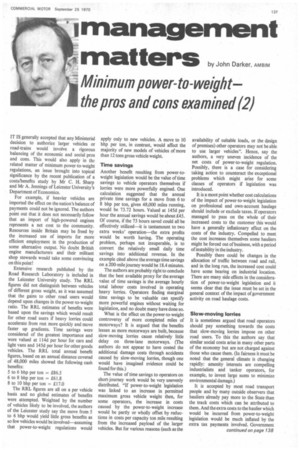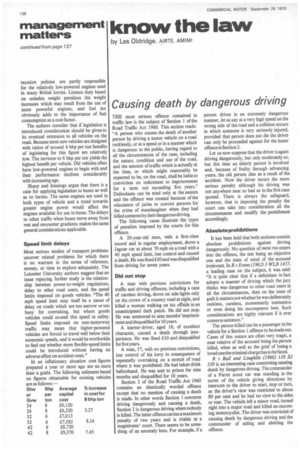'management
Page 139

Page 140

If you've noticed an error in this article please click here to report it so we can fix it.
matters by John Darker, AMBIM
a Minimum power-to-weight- the pros and cons examined (2)
IT IS generally accepted that any Ministerial decision to authorize larger vehicles or road-trains would involve a rigorous balancing of the economic and social pros and cons. This would also apply in the related matter of minimum power-to-weight regulations, an issue brought into topical significance by the recent publication of a costs/benefits study by Mr C. H. Sharp and Mr A. Jennings of Leicester University's Department of Economics.
For example, if heavier vehicles are imported the effect on the nation's balance of payments could not be ignored. The authors point out that it does not necessarily follow that an import of high-powered engines represents a net cost to the community. Resources inside Britain may be freed by the increased use of imports for more efficient employment in the production of some alternative output. No doubt British engine manufacturers and their militant shop stewards would take some convincing on this point!
Extensive research published by the Road Research Laboratory is included in the Leicester University study. The RRL figures did not distinguish between vehicles of different gross weight, as it was assumed that the gains to other road users would depend upon changes in the power-to-weight ratio. The RRL estimates of benefits were based upon the savings which would result for other road users if heavy lorries could accelerate from rest more quickly and move faster up gradients. Time savings were considered of the greatest importance and were valued at 114d per hour for cars and light vans and 145d per hour for other goods vehicles. The RRL total annual benefit figures, based on an annual distance covered of 48,000 miles showed the following cash benefits: 5 to 6 bhp per ton = £86.5 6 to 8 bhp per ton = £61.8 8 to 10 bhp per ton = £17.0 The RRL figures are all on a per vehicle basis and no global estimates of benefits were attempted. Weighted by the number of vehicles likely to be involved, the authors of the Leicester study say the move from 5 to 6 bhp would yield little gross benefits as so few vehicles would be involved—assuming that power-to-weight regulations would apply only to new vehicles. A move to 10 bhp per ton, in contrast, would affect the majority of new models of vehicles of more than 12 tons gross vehicle weight.
Time savings Another benefit resulting from power-toweight legislation would be the value of time savings to vehicle operators themselves if lorries were more powerfully engined. One calculation suggested that the annual private time savings for a move from 6 to 8 bhp per ton, given 48,000 miles running, would be 73.72 hours. Valued at 145d per hour the annual savings would be about £45. Of course, if the 73 hours saved could all be effectively utilized—it is tantamount to two extra weeks' operation—the extra profits would be worth having. The operating problem, perhaps not insuperable, is to convert the relatively small daily time savings into additional revenue. In the example cited above the average time savings on a 200-mile journey would be 18.4 minutes.
The authors are probably right to conclude that the best available proxy for the average value of time savings is the average hourly total labour costs involved in operating heavy lorries. Operators finding marginal time savings to be valuable can specify more powerful engines without waiting for legislation, and no doubt many have done so.
What is the effect on the power-to-weight controversy of more completed miles of motorways? It is argued that the benefits lessen as more motorways are built, because slow-moving lorries cause relatively little delay on three-lane motorways. (The authors do not appear to have costed the additional damage costs through accidents caused by slow-moving lorries, though one would have imagined evidence could be found for this.) The value of time savings to operators on short-journey work would be very unevenly distributed. "If power-to-weight legislation was linked to an increase in permitted maximum gross vehicle weight then, for some operators, the increase in costs caused by the power-to-weight increase would be partly or wholly offset by reductions in costs per capacity ton mile resulting from the increased payload of the larger vehicles. But for various reasons (such as the availability of suitable loads, or the design of premises) other operators may not be able to use larger vehicles". Hence, say the authors, a very uneven incidence of the net costs of power-to-weight regulation. Possibly, there is a case for considering taking action to counteract the exceptional problems which might arise for some classes of operators if legislation was introduced.
It is a moot point whether cost calculations of the impact of power-to-weight legislation on professional and own-account haulage should include or exclude taxes. If operators managed to pass on the whole of their increased costs to the customer this would have a generally inflationary effect on the costs of the industry. Compelled to meet the cost increases themselves some hauliers might be forced out of business, with a period of instability in the industry.
Possibly there could be changes in the allocation of traffic between road and rail, and in the long run, the increased cost could have some bearing on industrial location. There are many side effects in the consideration of power-to-weight legislation and it seems clear that the issue must be set in the general context of the impact of government activity on road haulage costs.
Slow-moving lorries
It is sometimes argued that road operators should pay something towards the costs that slow-moving lorries impose on other road users. To this the authors say that similar social costs arise in many other parts of the economy but are not charged against those who cause them. (In fairness it must be noted that the general climate is changing rapidly: amenity interests are compelling industrialists and tanker operators, for example. to invest large sums to minimize environmental damage.)
It is accepted by most road transport people and by many outside observers that hauliers already pay more to the State than the track costs which can be attributed to them. And the extra costs to the haulier which would be incurred from power-to-weight legislation would be much inflated by the extra tax payments involved. Government taxation policies are partly responsible for the relatively low-powered engines used in many British lorries. Licence duty based on unladen weight penalizes the weight increases which may result from the use of more powerful engines, and fuel tax obviously adds to the importance of fuel consumption as a cost factor.
The authors consider that if legislation is introduced consideration should be given to its eventual extension to all vehicles on the road. Because most new vehicles are designed with ratios of around 6 bhp per ton benefits of legislating for this figure are relatively low. The increase to 6 bhp per ton yields the highest benefit per vehicle. Old vehicles often have low-powered engines to begin with and their performance declines considerably with increasing age.
Sharp and Jennings argue that there is a case for applying legislation to buses as well as to lorries. The same engines are used in both types of vehicle and a trend towards greater engine power would affect the engines available for use in buses. The delays to other traffic when buses move away from rest and encounter gradients makes the same general considerations applicable.
Speed limit delays Most serious studies of transport problems uncover related problems for which there is no warrant in the terms of reference, money, or time to explore adequately. The Leicester University authors suggest that an issue repaying further study is the relationship between power-to-weight regulations, delay to other road users, and the speed limits imposed on goods vehicles. "The 40 mph speed limit may itself be a cause of delay on roads which are too narrow or too busy for overtaking, but where goods vehicles could exceed this speed in safety. Speed limits imposed on non-motorway traffic may mean that higher-powered vehicles are forced to travel well below their economic speeds, and it would be worthwhile to find out whether more flexible speed limits could be introduced without having an adverse effect on accident rates."
In an inflationary situation cost figures prepared a year or more ago are no more than a guide. The following estimates based on figures obtainable for existing vehicles are as follows:—


























































































































































































